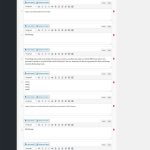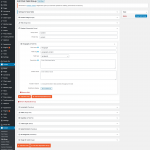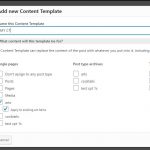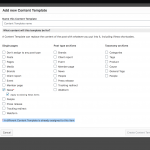Hello
I am migrating from Drupal to WordPress using the FG Drupal to WordPress plugin. I have been able to migrate the content successfully apart from one issue - In the Drupal posts that contained Paragraphs, any content after the first Paragraph is not displayed on the front end.
In this example you can see the original Drupal site post with all content here: hidden link
vs.
The migration WP test site post: hidden link
You can see how in the WP site the content is cut short. No images were pulled to the test site deliberately so I could migrate faster for the purpose of this example.
I have attached a screenshot of the backend for the posts on the WP site that shows how the missing content has actually been migrated in Fields, but is not visible on the front end.
I do not have the technical skills to edit the theme's template, so I was hoping I could get the missing Field content to appear on the front end of the WP post type using Toolset?
Many thanks,
Zak
Hello,
Thanks for the details, I can see the difference between original Drupal website and new WordPress site.
In your screenshot:
https://toolset.com/wp-content/uploads/2020/08/1735251-screencapture_ecoa4_sg_host_wp_admin_post_php_2020_08_11_22_54_44_1.jpg
I assume we are talking about the field "Content" in above screenshot, it seems to be a multiple instance field, isn't it? And all those content should be imported into WordPress post content area.
This should be an issue of the "FG Drupal to WordPress" plugin, according to our support policy, we can not provide other plugin support:
https://toolset.com/toolset-support-policy/
I suggest you check it with the "FG Drupal to WordPress" plugin author to fix the problem:
https://wordpress.org/support/plugin/fg-drupal-to-wp/
For the question: could get the missing Field content to appear on the front end of the WP post type using Toolset?
Yes, it is possible, you can display the "news" post body+ multiple instance "content" field value in front-end of single "news" post, for example:
1) Create a content template for single "news" post
https://toolset.com/course-lesson/creating-templates-to-display-custom-posts/
2) In above content template, display post body + "content" field value
Hi Luo
I had checked in with FG plugin support initially, who said to display the fields on the front-end, I had to either customize the theme or use the Toolset Views plugin. There a no options in the plugin for mapping or relationships during a migration.
Is there way to display the content from the fields without using a template? I'll be eventually using a theme with its own template for post content.
Many thanks
Zak
There is a misunderstanding, the Toolset Content Template(Toolset Blocks plugin) isn't theme file, you can setup it by following the document I mentioned above:
https://toolset.com/course-lesson/creating-templates-to-display-custom-posts/
With Toolset Content Template, you can display the post body + custom field "content" values in front-end easily.
If you don't want to use Toolset Blocks plugin, you will need to edit your theme file, for example "single-news.php":
https://developer.wordpress.org/themes/basics/template-hierarchy/#single-post
And use PHP codes to display the custom field "content" value:
https://toolset.com/documentation/customizing-sites-using-php/functions/
Hi Luo
I was able to create the content templates and pull almost all the News group fields apart from the Content (repeatable group). It didn't appear as an option when selecting the toolset blocks, all the other fields were selectable from the dropdown after choosing News group as the source. This is the field I need the most to appear in the template.
I've attached a screen grab of the News group fields
I also deleted the content template when resetting the Drupal plugin to do a new migration, and I now get the error message "You attempted to edit a Content Template that doesn’t exist. Perhaps it was deleted?" when I try to create a new content template for the News post again.
Thanks
Zak
Dear Zak,
Toolset repeatable group is based on one-to-many relationship, each item of repeatable group is also a post, so you will need to add a view block in your content template to display the related repeatable group items, see our document:
https://toolset.com/course-lesson/creating-and-displaying-repeatable-field-groups/
Section "Displaying Repeatable Field Groups"
For the content template issue, you can create the new content template manually by these:
Dashboard-> Toolset-> Content Templates, Add new, choose the specific post type, for example "News"
See my screenshot my-ct.JPG
Hi Luo
When I try to create the template manually I get the attached error message.
Zak
You can ignore that message, the new content template will be able to override the old content template.
And you can also find and delete the old content template here:
Dashboard-> Toolset-> Content Templates, click the "Trash" link, find and Delete Permanently that old one.
Hi Luo
The old one wasn't in the trash, but I was able to restore earlier version of the site from a backup, which had the template and work on it from there.
I was also able to get the repeatable group content to appear in the template. The only issue is that not all the content in the group appeared. You can see via these links:
Original post
hidden link
New post
hidden link
The content was displayed up until the paragraph with the word "Item", with three images and paragraphs left.
Thanks
Zak
Thanks for the details, I have compared the URLs you mentioned above:
New post(WordPress) page 2:
hidden link
It is ended with: You can find in-depth analysis of some of the key approaches outlines below in rén collective’s free guide
Original post(drupal):
hidden link
There are some paragraphs, from:
Everything starts with your design
To:
Some suppliers currently available on the market are Piñatex, Bananatex, Vegea, Orange Fiber, Fulgar and Desserto.
Is this the problem you mentioned above?
If it is, you will need to check the plugin author of "FG Drupal to WordPress plugin", where does those those approaches go into WordPress, if they are in custom fields, you can follow the same steps to display them into your content template.



